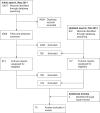Impact of HIV-related stigma on treatment adherence: systematic review and meta-synthesis
- PMID: 24242258
- PMCID: PMC3833107
- DOI: 10.7448/IAS.16.3.18640
Impact of HIV-related stigma on treatment adherence: systematic review and meta-synthesis
Abstract
Introduction: Adherence to HIV antiretroviral therapy (ART) is a critical determinant of HIV-1 RNA viral suppression and health outcomes. It is generally accepted that HIV-related stigma is correlated with factors that may undermine ART adherence, but its relationship with ART adherence itself is not well established. We therefore undertook this review to systematically assess the relationship between HIV-related stigma and ART adherence.
Methods: We searched nine electronic databases for published and unpublished literature, with no language restrictions. First we screened the titles and abstracts for studies that potentially contained data on ART adherence. Then we reviewed the full text of these studies to identify articles that reported data on the relationship between ART adherence and either HIV-related stigma or serostatus disclosure. We used the method of meta-synthesis to summarize the findings from the qualitative studies.
Results: Our search protocol yielded 14,854 initial records. After eliminating duplicates and screening the titles and abstracts, we retrieved the full text of 960 journal articles, dissertations and unpublished conference abstracts for review. We included 75 studies conducted among 26,715 HIV-positive persons living in 32 countries worldwide, with less representation of work from Eastern Europe and Central Asia. Among the 34 qualitative studies, our meta-synthesis identified five distinct third-order labels through an inductive process that we categorized as themes and organized in a conceptual model spanning intrapersonal, interpersonal and structural levels. HIV-related stigma undermined ART adherence by compromising general psychological processes, such as adaptive coping and social support. We also identified psychological processes specific to HIV-positive persons driven by predominant stigmatizing attitudes and which undermined adherence, such as internalized stigma and concealment. Adaptive coping and social support were critical determinants of participants' ability to overcome the structural and economic barriers associated with poverty in order to successfully adhere to ART. Among the 41 quantitative studies, 24 of 33 cross-sectional studies (71%) reported a positive finding between HIV stigma and ART non-adherence, while 6 of 7 longitudinal studies (86%) reported a null finding (Pearson's χ (2)=7.7; p=0.005).
Conclusions: We found that HIV-related stigma compromised participants' abilities to successfully adhere to ART. Interventions to reduce stigma should target multiple levels of influence (intrapersonal, interpersonal and structural) in order to have maximum effectiveness on improving ART adherence.
Keywords: HIV; adherence; disclosure; poverty; social support; stigma.
Figures



References
-
- Paterson DL, Swindells S, Mohr J, Brester M, Vergis EN, Squier C, et al. Adherence to protease inhibitor therapy and outcomes in patients with HIV infection. Ann Intern Med. 2000;133(1):21–30. - PubMed
-
- Bangsberg DR, Hecht FM, Charlebois ED, Zolopa AR, Holodniy M, Sheiner L, et al. Adherence to protease inhibitors, HIV-1 viral load, and development of drug resistance in an indigent population. AIDS. 2000;14(4):357–66. - PubMed
-
- Bangsberg DR, Perry S, Charlebois ED, Clark RA, Roberston M, Zolopa AR, et al. Non-adherence to highly active antiretroviral therapy predicts progression to AIDS. AIDS. 2001;15(9):1181–3. - PubMed
-
- Singh N, Squier C, Sivek C, Wagener M, Nguyen MH, Yu VL. Determinants of compliance with antiretroviral therapy in patients with human immunodeficiency virus: prospective assessment with implications for enhancing compliance. AIDS Care. 1996;8(3):261–9. - PubMed
-
- Mehta S, Moore RD, Graham NM. Potential factors affecting adherence with HIV therapy. AIDS. 1997;11(14):1665–70. - PubMed
Publication types
MeSH terms
Substances
Grants and funding
LinkOut - more resources
Full Text Sources
Other Literature Sources
Medical

